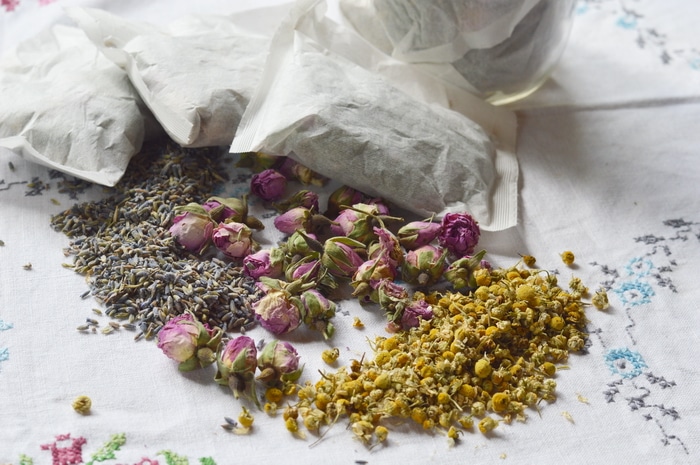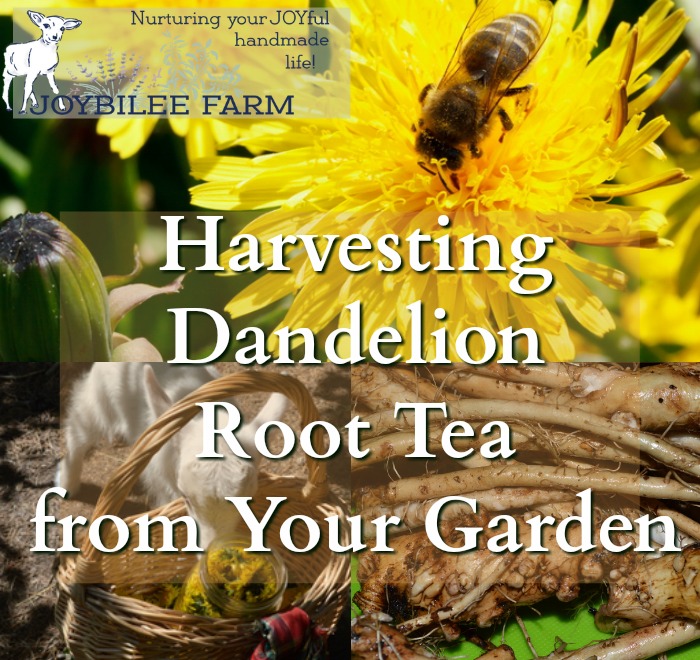Prepackaged herbs for tea are available at any grocery store, but making them yourself gives access to a wide variety of flavour combinations. Use our secret formula for better tea blends.
Because we live in a cold climate herbal tea is a regular part of most days. I may start with one or two cups of coffee for a pick-me-up, but drinking herbal tea throughout the day gives me a boost of vitamins, antioxidants, and medicinal benefits with each cup. You can use homegrown herbs for tea or purchase dried herbs in bulk. Either way, don’t pass up on the easy and healthy benefits you get by drinking herbal tea daily.

What is the difference between a tea and an infusion?
Short answer: Tea has a shorter brewing time than an infusion.
Tea is made with a short infusion time of up to 15 minutes that extracts the flavonoids from the herbs but leaves a lot of the minerals behind. By brewing herbs with a long infusion of 4 to 8 hours, more of the minerals are extracted into the liquid. This leaves the minerals in the infusion ready to be assimilated when you drink it. You can do both with the same blends. My daughter likes blending raspberry leaf, mint, and nettle for a energy boosting tea, but will also use the same blend for a mineral rich infusion.
When you brew herbs is it a tea or a tisane?
Herbal tea is technically a ‘tisane’ since it is not brewed from the traditional tea leaves of the Camellia sinensis plant. I will still use the term tea in this article as I discuss the ways to make an herbal tea, herbal decoction, and herbal infusion. Herbal tea is caffeine-free and is a good way to use herbal medicine. Most herbal constituents and antioxidants are water soluble and tea is a relaxing way to take them.

How to make your own custom herbal tea blends
Herbal Tea has been around since people started using plants for pleasure and medicine, so we often have an underlying motivation when making an herbal tea. It could be used for relaxation after a long day at work, as a way to support our immune system, or as a refreshing cool beverage on a warm day.
Choose loose herbs with this formula:
- Start with a dried herb as the base ingredient. These herbs will have a mellow flavour that will go with the most complementary and accent herbs. These are the herbs that have the main flavour or herbal action that you want. For instance, when making an herbal tea for relaxation you may use chamomile as your main herb. If you want to improve cognitive function, memory, or ease depression ginkgo biloba is a great choice as a base tea herb.

- Next, add a complementary ingredient for a different effect or flavour. For instance, peppermint or chocolate mint, is often added to chamomile to add to the relaxing effect, relieve anxiety or insomnia, and to stimulate the taste buds. Chamomile is also a digestive remedy and helps relieve nausea, upset stomach, and indigestion. It has anti-inflammatory properties and it can help relieve menstrual cramps.

- The last ingredient is an accent herb which gives you the ability to add intense flavour that will round out the other two ingredients. A berry or a little spice like cinnamon or fennel can be added to make the tea more interesting to your taste buds. These tasty herbs also carry some strong herbal benefits. For instance, cinnamon helps keep blood sugar in the healthy range and can support weight loss goals.

Start by combining 3 parts (3 teaspoons) base ingredient, 1 to 2 parts complementary herb (1 to 2 teaspoons), and 1/4 to 1 part (1/4 to 1 teaspoon) of accent herbs and spices. Use 1 to 3 teaspoons of this mixture for your tea. Always cover the cup or teapot to hold in the volatile oils. These oils are where most of the flavour comes from as well as the therapeutic benefits of herbal tea.
You’ll want to start creating your original herb mixes in small batches so you can make adjustments as you are perfecting your recipes.

Tips for brewing tea and infusions
When working with leaves and flowers pour boiling water over the plant material. Commercial Tea Bags contain about 1 gram of tea. When making healing herbal tea you need to use at least 1 tablespoon of plant material, which is about 3 to 5 tea bags of commercial herbal tea. Cover the cup or French press to prevent volatile oils from escaping. Steep 15 minutes. Strain and drink.

Some base herbs to consider:
- Mint – spearmint, peppermint, apple mint
- Bee Balm (Monarda)
- Lemon Balm
- Holy basil or Tulsi
- Raspberry Leaf
- Lemon Verbena
- Anise Hyssop
- Lemongrass
- Chamomile tea
- Yerba Mate
- Stinging Nettle
- Linden flowers
- Dandelion Root
- Gingko biloba leaves

Complementary herbs and spices might include
- Lavender
- Rosemary
- Rose hips
- Hibiscus tea
- Lemon Thyme
- Calendula
- Elderberry
- Pine Needles
- Pineapple sage or sage

Accent herbs and spices to consider
- Cinnamon bark
- Ginger (dried or candied)
- Lemon zest
- Orange zest
- Jasmine flowers
- Rose petals
- Cardamom pods
- Star anise
- Cloves
- Turmeric
- Fennel seeds

How to Make an Herbal Decoction
When working with harder herbal materials like seeds, roots, and dried fruit you need to simmer the herbs in water to soften them and release their beneficial qualities into the water.
- Simmer at least 1 tablespoon of herbs in 2 cups of water, in a covered saucepan for 15 minutes. During the simmering process, some of the water will evaporate.
- Remove the herbs from the heat and allow the decoction to steep an additional 15 minutes before straining. Strain and drink.
Herbal tea and decoctions don’t keep long, so be sure to put any unused portions in the refrigerator.
This process makes your drink high in valuable protein, minerals, and active ingredients, the things your body needs, but also the things that bacteria like to thrive in. Your herbal decoctions should be made fresh daily.

Nourishing Herbal Infusions
Infusions are made with herbs that don’t necessarily have a pleasant taste so you may have trouble getting other family members to drink up. You can make them more palatable by adding a bit of tulsi, lemon balm, peppermint or anise hyssop to the infusion to sweeten the flavour.
Brewing herbs with a long infusion will take from 4 to 8 hours, but the extra time with worth it. More of the minerals found in the plants are extracted into the resulting liquid. This leaves the minerals in the infusion ready to be assimilated when you drink it.
Try 1 teaspoon of these flavour enhancers per 2 cups of infusion, and steep it along with the nourishing, mineral-rich herbs, to make them more palatable for the uninitiated. Tulsi goes really well with stinging nettle and is a little less “green” tasting, according to my husband.
Nourishing herbal long infusions were made popular by herbalist Susan Weed. Susan suggests rotating a daily drink of nourishing herbal infusions, rotating between different herbs. Try these instead of chemical vitamins for your one-a-day habit.
Since these are food there are no contraindications, unless you are allergic to one of these herbs.

5 Herbal Infusion Tea Recipes
Burdock Root
(Per serving: 1 ounce in 2 cups of boiled water, brew for 8 hours)
Very high in chromium, iron, magnesium, silicon, and thiamine; high in cobalt, phosphorus, potassium, sodium, tin, vitamin A, and zinc
Milky Oats
(Per serving: 1 ounce in 4 cups of boiled water, brew for 4 hours)
Very high in chromium, magnesium, silicon, and sodium; high in calcium, niacin, and vitamin A

Red Clover Flowers
(Per serving: 1 ounce in 4 cups of boiled water, brew for 2 hours)
Very high in chromium and tin; high in calcium, magnesium, niacin, phosphorus, potassium, thiamine, and vitamin C
Red Raspberry Leaf
(Per serving: 1 ounce in 4 cups of boiled water, brew for 4 hours)
Very high in iron, manganese, and niacin; high in calcium, magnesium, selenium, tin, vitamin A, and vitamin C. Raspberry leaves are tonic to the womb and support women throughout the child bearing years and in menopause. Raspberry leaves are safe to drink in tea throughout pregnancy. Women in their first trimester should speak to their midwife about their personal situation before using raspberry leaves in large quantities.
Stinging Nettle
(Per serving: 1 ounce in 4 cups of boiled water, brew for 4 hours)
Very high in calcium, chromium, magnesium, and zinc; high in cobalt, manganese, phosphorus, potassium, riboflavin, selenium, silicon, thiamin, vitamin A, and vitamin C
Nourishing herbal infusions should also be kept refrigerated after their steeping time. Make enough to use them fresh each day.
Creative Ways to Use Herbal Tea and Infusions
Enjoy your cup of tea.
You can use a common tree that is easy to find and tastier than you might think when you learn how to Make Pine Needle Tea for Vitamin C and Wellness.
Our article Planning Your Herbal Tea Garden for Increased Potency and Better Flavor Even if You Live in Zone 3 has recipes for Morning Tea and Relaxing Tea.
Once you arrive at an herbal tea recipe that you love, use this idea from Food52, and make cookies with your tea blends. This recipe for vanilla rooibos tea cookies could be adapted for any herbal blend you’ve created. Or try these teabag cookies for your next tea time.
Learn to use garden herbs to make inspiring botanical beverages
For more recipes that can help you beat the heat check out my Inspiring Botanical Drinks course. Inside this class you’ll learn how to use your garden herbs and produce to create elixirs, drinks, and cold treats that are healthy, full of antioxidants, and will help you stay cool all summer long. You’ll also learn healthy ways to beat the soda habit, make your own coffee shop drinks, and craft specialty beverages that are lovely and giftable. Learn more here.






One problem these types of articles is that no one days HOW to determine what makes a base, a complimentary and an accent herb….how do you decide? Can chamomile be a complementary as well as a base?? Can one herb be all three at different times? Or is chamomile only a base? Etc.
Thank you for the post.
I wanted to create an energy boosting tea. The ingredients I came up with are maca root and eleuthero as a base carob for a supporting herb and cinnamon as an accent. Does this sound right?
I definitely would. They are rich in antioxidants. My favorite green tea is Dao Ren, and I use it all the time for my kombucha
What are your thoughts on using green tea leaves as a base for a blend?